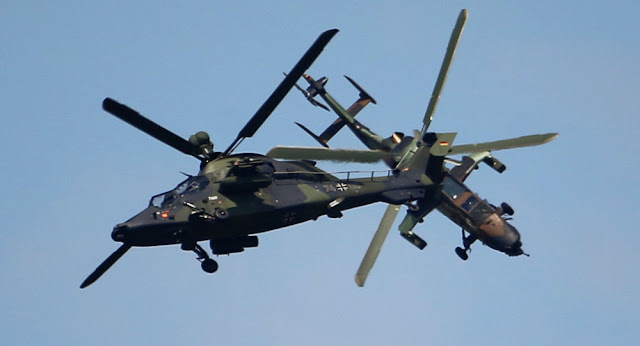T.Wiegold August 10, 2017 ·
After the crash of a Tiger combat
helicopter of the Bundeswehr in Mali on
July 26, the manufacturer company Airbus Helicopters issued a
safety warning to all users of this helicopter type, which was supplemented on
(today) Thursday again. In this, as a precaution, all variants of the
helicopter used by the French, Spanish and Australian armed forces are declared
insecure.
Although the company was not involved in the
investigation of the accident and did not have any information that went beyond
the Bundeswehr's first examination results, Airbus Helicopters explained in
the Tiger Safety Warning TSW_AHT_2017_002 , eyes
straight ahead! is present. Yet:
Airbus Helicopters declares to UNSAFE condition for all
Tiger versions. AH can neither identify the part, the failure of which
would lead to the accident, nor the origin of the failure (design,
manufacturing, maintenance). Consequently, AH is not in the position to
propose a protective measure.
The General Flugsicherheit of the German
Armed Forces had reported the first findings on Tuesday, but they continue to
provide no information about the cause of the accident. These findings were also communicated
to the
Defense Committee of the Bundestag . However, the Bundeswehr
report mentions a detail that is missing in the letter to the deputies: What is
described thus, which the aircraft surprisingly radically lowered its
nose, has formulated the General Flugsicherheit more
drastically: when the aircraft drove the nose by 90 degrees and A steep
descent began - that is, actually downwards. That all rotor
blades were separated from the engine had been a result of this rapid descent.
From the four user nations of the tiger, keeping
information straight from eyes! So far only Spain all machines on the
ground. The tigers in France and Australia do not use
routine flights, but they start with training flights, which are necessary for
the maintenance of skills or to prepare for a mission. Germany does not
allow all helicopters of this type to start in principle, but in the case of
danger to life and limb, for example, in a fighting situation in Mali.
Supplement from the Federal Press Conference on 11
August: I asked the deputy spokesman of the Ministry of Defense, Colonel Boris
Nannt, why the company is not directly involved in the investigation:
Transcript of Audios:
Q: I have a question to the Ministry of
Defense on the "Tiger" Crash in Mali. Airbus yesterday issued a
safety warning for the "Tiger" and declared all "Tiger"
versions for "condition unsafe". At the same time, Airbus also
let - or is part of the safety warning - that Airbus is not involved in the
investigations. Why is that?
Named: We are concerned with doing everything
to elucidate the causes of this terrible disaster. In the case of the
"Tiger" combat helicopter, the industry has already offered its
support. Of course we will also use them. I know that Airbus has
already delivered insights into technical issues over the past few
days. They are also included in the investigation. If we have any
questions, we are approaching Airbus. I know that General Air Safety is
already in touch and also in dialogue with Airbus to do everything possible to
resolve the disaster. My point is that you are in dialogue. We lead
the investigations; That is our responsibility. We will involve
Airbus on the industry as needed.
Additional question: Just so I understand
this correctly: Why is not a representative of the manufacturer company part of
the investigation group, the investigation team or whatever one calls it?
Named: This is basically not planned by the
process. We are the one who is responsible there. But, of course, we
get the insights from Airbus or from other industrial companies, if there are
any incidents to do anything to clarify this.
(Archive image: A French patrol, watched from the air by
a Tiger combat helicopter, in October in the north of Mali - French Ministry of
Defense)
Related article:
EC665 TIGER HAD: Details


No comments:
Post a Comment